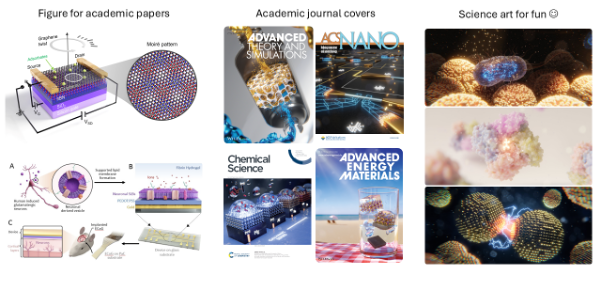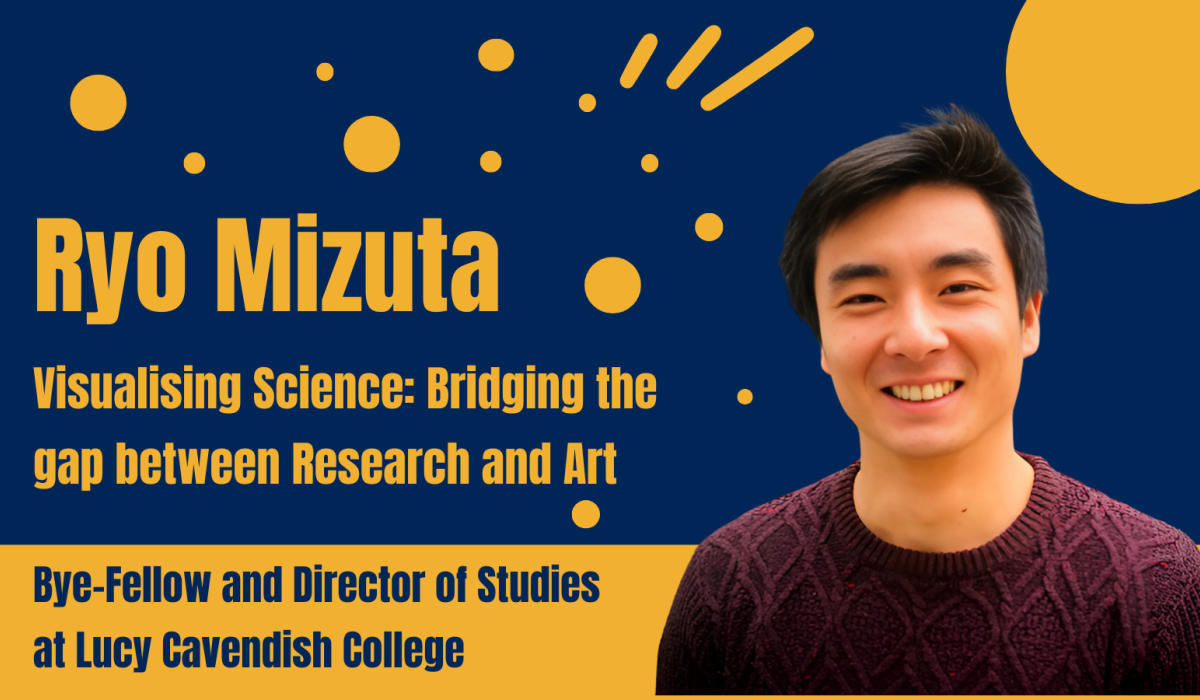This week we speak with Ryo Mizuta, Senior Teaching Associate of the NanoDTC and this year Lucy’s DoS for Natural Sciences Physics Parts II and III. Here, he shares his work on science communication and graphic design.
Thanks for speaking with us Ryo! Can you tell me how you got started with graphics and science communication?
Sure! My journey into graphics really started out of necessity during my PhD. Like many researchers, I was often struggling to communicate my ideas in a way that would resonate with others. Writing and equations only go so far—especially when you're dealing with complex concepts that are easier to grasp visually. So, I began experimenting with visuals. I started small, using basic tools like PowerPoint to create simple shapes and 2D figures. But it quickly became clear that I needed more if I wanted to bring my ideas to life.
Eventually, I stumbled upon Sketchup, which allowed me to create and share 3D models. It’s a platform typically used in architectural and design fields, but I realised it had a lot of potential for science as well. That was my first real dive into 3D visualisation, and it opened up a world of possibilities. After that, I found Blender—a powerful 3D software that is generally used for visual effects in movies, 3D animations, game development and more. At first, Blender was pretty intimidating; the interface was complex and not exactly user-friendly. But I kept practicing, and over time, I grew comfortable with it. Now, it’s my go-to tool for creating 3D visualisations. This eventually brought me into science communication, where I use these visuals to help others understand and appreciate science in new ways.
Could you share a bit about what you're working on now?
Absolutely! My current work is a blend of science and art, focused mostly on creating visual content for academic journals and grant proposals. My bread and butter are what I’d call “scientific storytelling” through graphics. For instance, I might create a cover illustration that visually captures the essence of a research paper or an entire proposal. A lot of my clients are researchers who want to condense years of complex work into a single, engaging image for grant applications. Besides that, I also create scientific animations for startups and small companies.
This type of work isn’t just about making something visually appealing; it’s about getting the science right. Each figure has to be scientifically accurate and able to stand on its own. It has to tell a story that resonates with both the scientific community and a broader audience. So, it’s a creative process that involves both technical knowledge and a good sense of visual storytelling.

You’re active on a few online platforms—could you tell us about them and what you do there?
Yes, I’m fairly active on YouTube, Instagram, and I have a personal website as well.
I put the most effort into my YouTube channel is really dedicated to helping other scientists and students learn how to use tools like Blender for their own scientific visualisations. Each video usually has a focus that scientists can take and apply to their own work, whether it be creating a specific 3D model or a general workflow. My goal is to show viewers how they can create professional-quality visuals even if they’re new to 3D design. I also make some of 3D models that I introduce on YouTube available to download for free on Gumroad so that I can help as many scientists make their figures as quickly and easily as possible.
With all of that experience, what advice would you give to students who want to explore graphics or science communication?
Great question! My biggest piece of advice is simple: just get started. It’s easy to get stuck in what I call “tutorial mode,” where you keep watching instructional videos but don’t actually create anything of your own. I see a lot of students get trapped in that phase, but you’ll learn so much more by experimenting. Pick a simple project—maybe something you’re interested in or that relates to your research—and dive in.
What’s next for you? Any new projects or goals on the horizon?
Right now, I’m shifting more of my focus toward teaching and curriculum development. My ultimate goal is to create a program that helps bridge the gap between learning science and communicating it effectively. I’ve been collaborating with educational institutions to explore ways to bring scientific visualisation into the classroom.
I’m also looking to expand my YouTube content. I want to cover more about the artistic elements of scientific illustration, like composition, colour palettes, and layout, so students and researchers can approach science visuals as both a technical and creative process. I feel like the more accessible we make these skills, the more scientists can connect with the public and share their work effectively.




